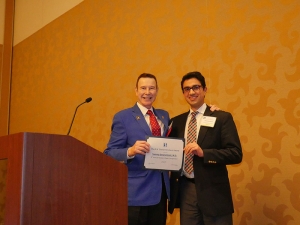The Rhinoplasty Society Meeting
 My wife and I attended the annual meeting of The Rhinoplasty Society, of which I was a founding member more than twenty years ago and President in 2000 to 2001. This was our biggest attendance ever, and is a wonderful conjoined meeting of both plastic and reconstructive surgeons and facial plastic surgeons, which is exactly what we had initially conceived. The early goal finally seems to be within reach.
My wife and I attended the annual meeting of The Rhinoplasty Society, of which I was a founding member more than twenty years ago and President in 2000 to 2001. This was our biggest attendance ever, and is a wonderful conjoined meeting of both plastic and reconstructive surgeons and facial plastic surgeons, which is exactly what we had initially conceived. The early goal finally seems to be within reach.
Dr. Samander Dowlatshahi won the award for the best paper by a resident against stiff competition. This is research that we performed to show the microanatomy of the nostril rim. Commonly open rhinoplasty, which I do not perform, creates distortion of the rim, necessitating placement of cartilage grafts to prevent unwanted changes postoperatively. This distortion is a problem that does not ordinarily occur with closed (no external incision) rhinoplasty. We wanted to know why. It turns out that there is an “endoskeleton” — a natural internal supporting structure – – in the alar wall that is disrupted by the open rhinoplasty dissection and that requires support to keep the nostril from distorting or pulling up as the patient’s nose heals. We hope that this information will be useful to surgeons so they will better they understand what they are doing by their wide dissection and how to avoid creating problems for patients.
This kind of distortion is not one that I have faced in the past because I only enter areas that are directly related to the patient’s surgical goals. Thus my dissection is much more limited than is commonly practiced and, among other benefits, has the tremendous advantage of minimizing the chances of creating new deformities. My published research as indicated that new postoperative deformities are the most common reason that patients seek secondary correction. That is a sad commentary on the state of rhinoplasty as it is too often practiced, and is one of the reasons that drives me to continue to teach more conservative and directed techniques.